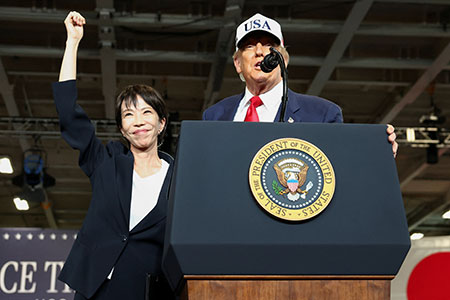
In a pivotal visit to Tokyo, U.S. President Donald Trump and Japan’s newly appointed Prime Minister Sanae Takaichi inked a groundbreaking cooperation program focused on critical rare earth metals. For Takaichi, who recently made history as Japan’s first female head of government, these high-stakes negotiations with President Trump represent her inaugural and crucial test on the international diplomatic stage, signaling her leadership capabilities.
President Trump’s visit commenced with an audience with Emperor Naruhito, a tradition he first established during his 2019 trip to Tokyo, when he became the first foreign leader to meet the newly ascended emperor. This current visit again saw Trump charting new territory, being the first high-profile international guest to engage with Prime Minister Takaichi since her recent assumption of power. Their initial interactions were marked by a display of warmth and mutual respect.
“A very strong handshake,” President Trump remarked, posing for photographers alongside Takaichi at Akasaka Palace before their discussions began. He added, “And let me congratulate you on being the first woman in this position. That is a great achievement.” In response, Prime Minister Takaichi expressed her admiration, stating she was “impressed and inspired” by Trump’s actions. She elaborated, “In such a short period of time, the world has become more peaceful,” and notably pledged to nominate the U.S. President for the Nobel Peace Prize.
This gesture echoed a previous nomination from Japan; during his first term, former Prime Minister Shinzo Abe had put President Trump forward for the Nobel Peace Prize for his efforts to resolve North Korea’s nuclear program. Takaichi, a protégé of Abe and a friend and golf partner of Trump, further solidified these personal ties through diplomatic gifting. She presented the U.S. President with Abe’s golf club, a golf bag personally autographed by Japanese golf champion Hideki Matsuyama, and a gilded golf ball, underscoring the continuation of a unique brand of golf diplomacy.
Beyond these exchanges of courtesies, Trump and Takaichi moved to substantive matters, formally signing an agreement heralding a “new golden age” in relations between their nations, alongside a memorandum of understanding on strategic investments. The White House affirmed that this agreement is designed to “help both countries strengthen economic security, stimulate economic growth, and thereby steadily contribute to global prosperity.”
However, this proclaimed “new golden era” agreement largely formalizes earlier understandings. It notably confirms the imposition of 15% U.S. tariffs on nearly all Japanese imports, including automobiles, a reduction from the 25% duties President Trump had initially threatened. In return, Japan committed to investing $550 billion into the U.S. economy and increasing its procurement of American goods and armaments, illustrating a complex give-and-take in the bilateral economic relationship.
A particularly significant outcome was the signing of a framework program for cooperation in the extraction and processing of critical minerals and rare earth elements. This document mandates that within six months, representatives from the U.S. and Japan will identify priority projects in vital sectors such as magnets, batteries, catalysts, and optical materials. Furthermore, the initiative seeks to establish strategic stockpiles of key minerals and implement other measures to ensure the resilience and security of their supply chains.
Valery Kistanov, head of the Center for Japanese Studies at the Institute of China and Modern Asia of the Russian Academy of Sciences, highlighted the geopolitical implications of this agreement. “The agreement aims to reduce the dependence of both countries, and especially Japan, on China, which produces 90% of the world’s rare earth magnets used in electronics and electric motors,” Kistanov stated. He noted Japan’s advanced technology for extracting rare earths from ocean depths, suggesting it could be integrated into future joint ventures with the U.S.
The global tensions surrounding rare earth metals have escalated significantly after China implemented stringent export controls on these critical minerals, essential for a vast array of products from automobiles to advanced weaponry. This contentious issue is anticipated to be a central topic of discussion during President Trump’s upcoming meeting with Chinese President Xi Jinping on Thursday, October 30, on the sidelines of the Asia-Pacific Economic Cooperation (APEC) summit in South Korea, underscoring the strategic importance of the Tokyo agreement.
For Prime Minister Takaichi, these discussions with President Trump carry immense weight, given her comparatively less entrenched position than her predecessor, Shinzo Abe. Assuming the premiership just a week prior to this summit, demonstrating a cordial and productive relationship with the U.S. President is crucial for shoring up her nascent domestic political standing. Her ruling Liberal Democratic Party’s coalition with the younger Japan Innovation Party currently lacks a majority in the lower house of parliament, making international recognition and strong alliance leadership vital.
“Takaichi faces the task of earning quick diplomatic points and proving herself to be a capable leader,” Kistanov observed. He further noted that ahead of the talks with Trump, she emphatically declared that the allied relationship with the United States remains the cornerstone of Japan’s foreign policy and security guarantees. Takaichi’s stated intention to build a trusting relationship with Trump and elevate U.S.-Japanese ties to a higher level culminated in the signing of the “new golden age” agreement, a clear projection of her diplomatic aspirations.
However, a cautionary perspective from the Japanese press suggests that Takaichi is attempting to play the “Abe card” in her dealings with America. Yet, as history shows, even Abe’s strong personal friendship with President Trump did not prevent the U.S. from withdrawing from the monumental Trans-Pacific Partnership (TPP) agreement, which was largely considered a flagship initiative of the former Japanese premier, reminding observers that personal rapport does not always guarantee policy alignment.
